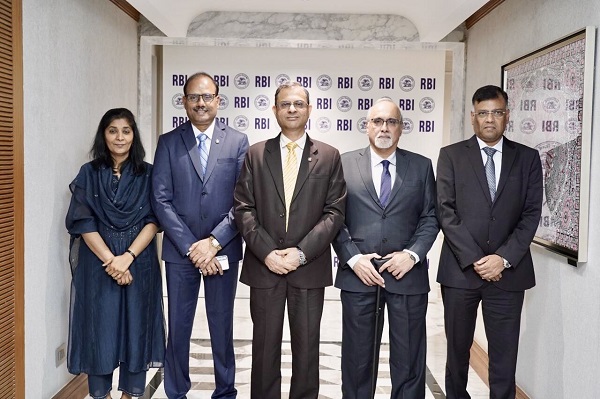.png)
Crawling Rupee, Creeping Risks on the RBI’s December Tightrope
A deceptive macro calm hides real fragilities, leaving the RBI heading into this review with plenty of room to misstep.

Gurumurthy, ex-central banker and a Wharton alum, managed the rupee and forex reserves, government debt and played a key role in drafting India's Financial Stability Reports.
November 27, 2025 at 6:33 AM IST
As the Monetary Policy Committee heads into its December 2025 review, the macro environment appears deceptively calm. Headline inflation has eased markedly, growth momentum seems steady, and the world, India included, is slowly adjusting to shifting geopolitical uncertainties. To a casual observer, another rate cut might look all but assured.
Yet beneath this statistical calm lies a more complicated reality. Credit appetite is weakening, the gap between core and headline inflation remains wide, the banking system’s role in channelling funds to the real economy is shrinking, and the rupee has now been classified by the IMF as operating under a crawl-like arrangement.
The RBI enters this policy review with plenty of room to misstep.
The RBI’s November 2025 Bulletin depicts an economy buoyed by festive demand, softer supply-side conditions, and the cushioning effect of GST rate cuts. October’s headline inflation of 0.3%, (estimated -0.25% for November), appears more than comfortable.
Yet these numbers risk being misleading.
- Core inflation continues to run materially higher, with sticky service prices and broader demand-side pressure. The divergence between core and headline suggests that low inflation might not yet be a structural victory yet as it is aided by temporary, tax-driven and supply-led boosts.
- Credit conditions are not roaring with appetite. Scheduled commercial bank credit growth (11.3%) is outpacing deposit growth (9.7%) – both in nominal and some interest-accrued terms, not due to a loan boom but because the funding base itself is tightening. Banks are lending more out of a relatively smaller pool of incremental deposits.
- Bank intermediation is narrowing as a channel of growth. The banking sector’s ability to act as a growth accelerant is weaker than headline credit numbers imply.
Put simply, this is not a macro landscape crying out for rate cuts.
Supply-led disinflation and shallow funding depth do not make the case for monetary easing. They call instead for restraint and careful calibration. The deeper point is that today’s low readings are flattered by a favourable base, and that very base will exert a mechanical upward pull on inflation in the months ahead. Reading these prints as a licence to ease would risk mistaking a statistical dip for a structural shift.
Rupee’s ‘Crawl’
This is not a policy change, but an acknowledgement.
- In an optimistic light, this shows maturity: the RBI now prefers gradualism over large, panicked interventions.
- In less flattering narrative, a “crawl” sounds like a slow slide, and investors tend to trade narratives, not nuances.
- Many might misunderstand the IMF’s rechristening India’s currency regime from “stabilised” to “crawling”, given the semantics around the word “stabilised”. The authorities might like to educate their audiences on this.
In a crawling-currency environment, aggressive rate cuts risk amplifying outflows. A narrowing rate differential with the US or Europe would only add to the perception that India is more relaxed about depreciation than it claims.
Governor Malhotra recently reminded viewers on a Hindi business channel that the rupee’s long-term strength depends on low inflation. Is that an admission to reveal why the RBI will not chase growth by slashing rates merely because headline inflation looks momentarily defeated?
When Malhotra front-loaded rate cuts and paired them with an aggressive CRR reduction in June 2025, the market reacted perversely. Yields rose, expectations flattened, trading liquidity dried up, and banks rotated into high-yield SDLs rather than central government securities. The unintended consequence of monetary activism was weaker, not stronger, transmission.
The lesson: Timing and signalling matter more than raw action. Monetary policy is not a showroom of boldness but a quiet art of sequencing.
Strategic Ambiguity
A premature easing would:
- reduce the rupee’s narrative strength,
- fail to meaningfully boost credit,
- misread supply-led disinflation as structural moderation,
- and weaken already fragile funding channels.
This is why the wisest move is neither a cut nor a hawkish freeze, but strategic ambiguity:
- keep future easing “on the table,” not on the calendar;
- fine-tune liquidity rather than slash rates;
- allow markets to anticipate without concluding.
A little unpredictability is healthy for bond market. Excess clarity dulls trading interest, whereas a controlled fog sustains two-way participation, all the more important at a time when government borrowing, both central and state, is anything but light.
As for the credit market, if the RBI had envisaged a six-month horizon in June to judge the effectiveness of transmission and the emergence of stronger credit growth, it is not obvious why it should not wait for that period to run its course before reassessing the relationship between rates and lending. The real question, then, is what meaningful advantage a rate cut would deliver at this stage.
India enters this policy review with a crawling rupee, festive-season data flattered by short-lived effects, a credit channel constrained by the shrinking role of banks in supplying funds to the real economy, and an inflation reprieve that owes more to supply relief and GST tweaks than to durable moderation. If one or two rate cuts are the only tools left, they are best deployed with care rather than haste. After all, if growth doesn’t borrow, how could rate-cuts help?



